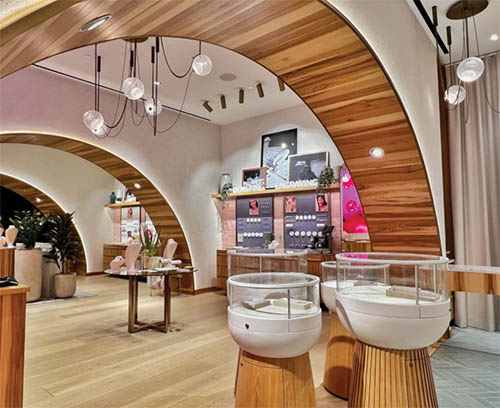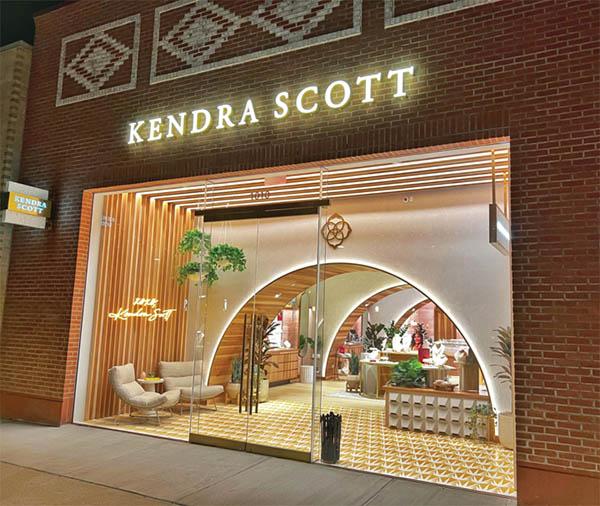— By Jaime Bettencourt —
Creating destination stores for lasting connections.
The meteoric rise of e-commerce has forced traditional brick-and-mortar retail to reckon with a new reality: physical stores must provide immersive in-store experiences. Retailers failing to integrate digital channels and offer the best of online shopping offline will struggle to stay competitive in this omnichannel environment.
Major brands have learned the hard way that simply having a physical location won’t suffice, with some closing hundreds of underperforming stores because they weren’t offering customers experiences beyond mere product displays and fitting rooms. Today’s stores focus on brand image, making every shopper feel like they’re visiting a tourist destination. How? By transforming their physical stores into truly immersive, experiential retail spaces.
The future of retail depends on harmonizing the convenience of e-commerce with the emotional power of physical experiences. Stores must move beyond lifeless product displays into imaginative havens centered on sensory engagement, service and community.
Experiential Retail Revolution
Retail giants are investing heavily in expansive interactive spaces, innovative technologies and hospitality services designed to inspire. About 2 in 5 retail companies ranked immersive experiences as a top investment priority, and 93% will “probably” or “definitely” do so in the next 3 years.

Creativity and human-centric technology — like interactive displays, experiential audio and scent marketing — are the differentiators driving loyalty and brick-and-mortar success. And the demand for these immersive elements is skyrocketing: 72% of consumers still shop in physical stores weekly.
With nearly 3 million retail trade businesses in the U.S. alone, brick-and-mortar remains vital for many brands, with 57.6% of retailers generating over half their revenue from in-store sales. Leading retailers are committed to creating destination stores going beyond simple transactions and building lasting connections. In this pursuit, retailers are reimagining in-store experiences:
• Digital innovations bring online conveniences into physical stores, such as virtual browsing apps and intelligent fitting rooms.
• Hospitality services include in-store coffee shops and beauty salons.
• Streamlined layouts now feature larger communal areas.
The consumer journey has evolved from just buying products. Leading retailers are laser-focused on creating destination stores that build brand love.
Key Trends Fueling the Revolution
Cutting-edge technologies offer exciting possibilities for engaging multiple senses and enhancing interactivity, opening up new frontiers in personalization. For instance, interactive displays help customers learn more about products and provide video demonstrations. Beacon technology offers personalized recommendations as customers move through the store. In addition, smart fitting rooms enable shoppers to request different sizes/styles with a simple tap on a screen. These innovations blend the convenience of e-commerce with a unique in-store twist, enriching the overall shopping journey.

Retailers collaborate with technology partners to implement innovative digital signage solutions to enhance the in-store retail experience. For example, we recently worked with Kendra Scott’s store design team to develop an immersive LED Visual Solution Wall. Seamlessly integrated into the store’s aesthetic, it showcases dynamic digital content highlighting the brand’s collections and story. We also designed visual digital solutions for the iconic Color Bar area. Such digital signage elevates the overall atmosphere of the store, engaging customers and reinforcing Kendra Scott’s brand identity.
The right technology can take brand experiences to the next level, but human-centric experiences remain vital. Our In-Store Customer Trends Data Report reports:
• Over half of customers appreciate tangibly connecting with products.
• Music drives mood and can elicit happiness from 55% of shoppers.
• The right ambient scent enhances the experience of 85% of customers.
• Nearly 75% of shoppers love interactive screens, and 69% are impressed by in-store video walls.
These physical engagements make brands memorable. Balancing high-tech immersion with high-touch customer service is key. Customers want tech-powered experiences and exceptional service.
Overcoming Experiential Challenges
Adapting to evolving consumer expectations is the top challenge for 42% of retailers. The modern customer seeks a shopping journey that blends engagement and convenience, requiring stores to offer a fresh, dynamic experience while maintaining brand authenticity.
Retailers are responding to evolving consumer needs by experimenting with more creative in-store visuals. A resounding 90% of brands prioritize immersive visual storytelling as a crucial store design element, incorporating technologies like digital interactive displays, 3D product visualizations and virtual reality experiences.
Digital integration, staff training, cost and privacy concerns are other challenges brands come up against. In overcoming these challenges, retailers can pave the way for a transformative retail landscape:
• Embracing technology integration keeps stores relevant in the digital age.
• Staff training cultivates a customer-centric workforce and improves staff retention.
• Technological costs are investments in lasting customer impressions and loyalty.
• Addressing privacy builds trust through transparent, responsible data use.
• Leveraging managed services ensures streamlined operations and optimal performance.
By navigating these challenges, retailers enhance their competitive edge while reshaping retail.
Collecting the right data is also critical for analyzing customer behaviors and measuring success. Data also provides metrics for engagement, generates actionable insights for optimizing experiences and informs decision-making.
Getting experiential retail right remains a process of testing, learning and evolving. With the right data foundation, retailers can turn challenges into opportunities to inspire customers in new ways.
Tips for Traditional Retailers
The experiential retail revolution may seem daunting for traditional retailers accustomed to conventional stores. However, brands can revamp their physical spaces to create immersive destinations by:
1. Implementing advanced augmented reality technology like virtual mirrors or product customization tools.
2. Incorporating gamification elements like rewards programs.
3. Hosting in-store events like new product previews, classes or pop-up shops to drive excitement and FOMO.
4. Using spatial design like art installations, 3D mapping projections and interactive environments.
5. Leveraging location-based notifications and mobile integrations like special offers based on in-store movement.
6. Strategically curating customized playlists for an enhanced atmosphere and brand image.
With creativity and customer-centric thinking, traditional retailers can keep pace with experiential disruptors. The brands that evolve their physical spaces into immersive havens will win over customers’ hearts, minds and wallets.
— Jaime Bettencourt, senior vice president of North American sales and brand strategy at Mood Media, is an accomplished senior-level sales and marketing leader with a robust track record for leading teams and leveraging custom, complex in-store marketing, media and technology solutions for Fortune 500 clients in the retail space.

